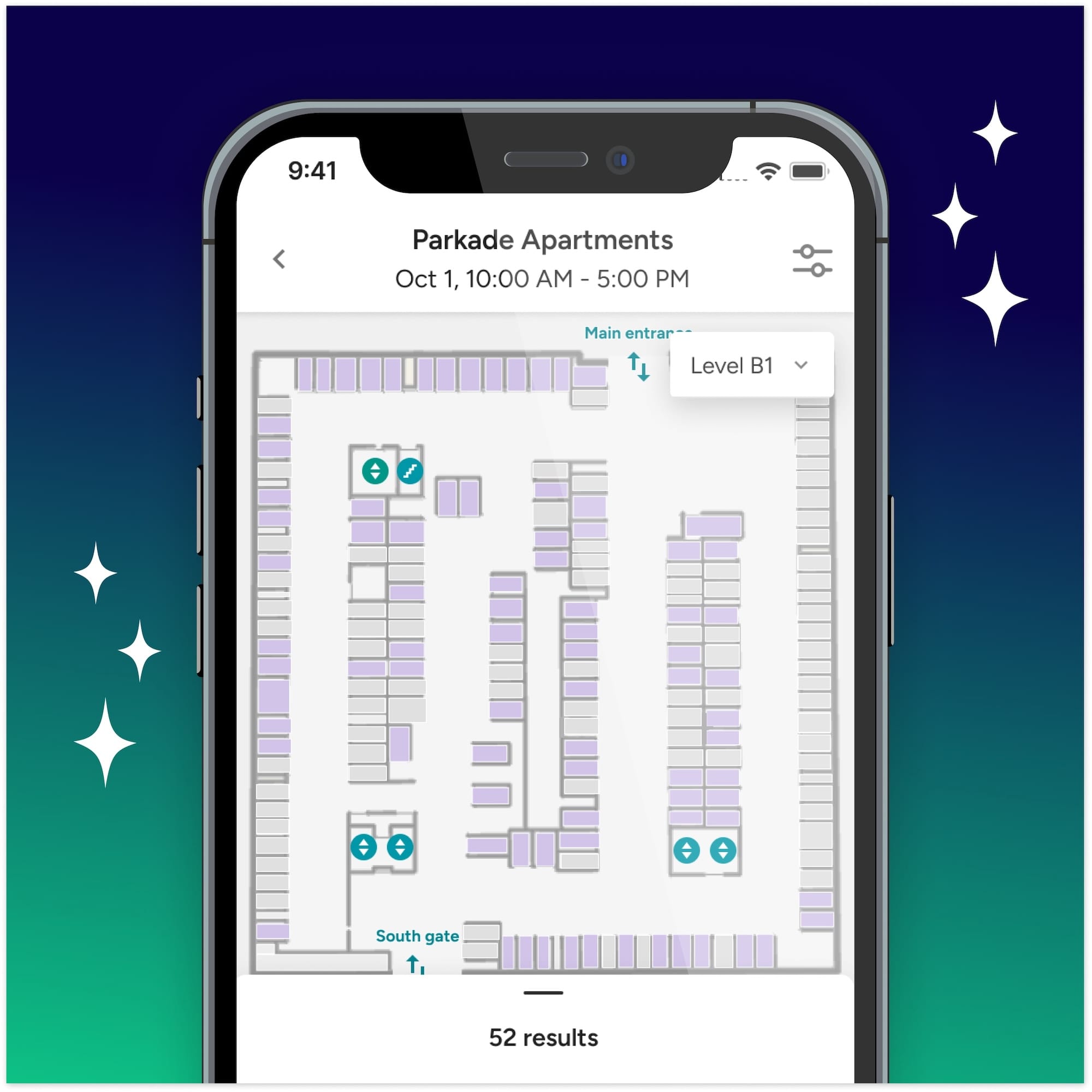

TABLE OF CONTENTS
EV parking spots are no longer a rare special feature at apartment complexes. With the rise of EV ownership that seems to accelerate every year, the ability for renters to charge at home is only going to become a bigger priority.
For property managers and owners, that means you may have to think a little more about how you’re going to charge for access to these chargers.
Why?
The higher demand will mean that, unless your spots are priced right, they’re going to get grabbed up at a higher rate than you can handle. In many of our customers’ lots or garages, EV spots are more likely to be at 100% occupancy than non-EV spots.
You also have to consider the high costs of installation for EV chargers. Initial installation costs are typically $1,000-2,500, but this can shoot way higher if you need to upgrade electrical infrastructure when making upgrades to existing buildings versus building from scratch.
The costs don’t stop at installation either. There are also ongoing operational costs like maintenance, subscription fees, and electricity consumption.
Pricing your EV parking spots right can help you manage this demand and offset the high costs associated.
Many properties are faced with this decision when installing EV chargers at their property — or revisiting their pricing strategy after having chargers for a while.
We’re going to go over the potential options, laying out the pros and cons and giving our suggestion for the most lucrative and effective strategy.
Some teams may want to leverage free EV charging in their marketing, using it to draw in more residents.
Typically, these are open spots that are available to both residents and guests. If you have assigned parking, these are usually extra spots that people can use for a limited period of time — i.e. 4 hour parking only while charging.
While the parking is free, you can opt to either provide the electricity for free or have the people charging take on the cost (we’ll talk more about this later).
This may initially seem like an attractive option to lure residents in, it’s often not quite as smooth in practice. First, you’d typically have to roll these costs into the rent prices, meaning non-EV owners would be subsidizing this amenity in part. Lower base rent is typically more attractive to potential renters, so using this as a marketing strategy may backfire.
Free EV parking spots can also lead to people overusing these spots, especially if you have a lot of electric vehicles at your property. It can turn into a messy free-for-all and residents may quickly become frustrated that these spots are never available.
Also, if these EV spots take up a portion of your guest parking, guests may be battling with residents for an open spot.
To give people more reliable access to an EV charger without passing costs onto them, you could make EV parking spots available on a first-come-first-served basis.
Whether you charge for parking or not, these assigned spots would be given to those who need chargers as they become available at no extra cost.
This may work if you have many spots with few residents with EVs, but if you have more residents who need these spots than spots available, you’d have to start a waitlist. Not only would this cause operational headaches for your staff, but it would also take away from a positive resident experience.
Residents may be waiting for months for a spot to open up — or never end up receiving a spot — and have no option to charge at home.
Many properties opt to handle EV spot demand and offset costs of maintaining chargers without sacrificing free parking to all other residents by just charging for a spot with a dedicated charger. This typically leads to more reliable availability of these spots.
Often, however, this passes large costs to the EV owners, which can make them upset, especially compared to the regular spots being free.
This is especially frustrating when there are a lot of empty EV spots, which is very common during a lease-up.
One reddit user mentioned his frustration with this situation. He lived at a complex where all regular parking was free while EV spots were $100 per month, and many of them sat empty as a result. Ultimately, he refused to pay the price and opted to cross his fingers that chargers at a nearby Walmart were available whenever he needed to charge.
Our rule of thumb is that you should always charge for parking, since it leads to many benefits for residents and building managers alike. So the solution we typically recommend to manage EV parking is to charge a premium on top of your normal pricing.
Since you’re already charging for parking, you won’t run into the problem we mentioned in option 3 of EV spots being unreasonably high to EV owners. The total revenue from parking can offset EV charging costs a bit.
When you offer “premium” spots with access to EV charging stations, people are able to reliably charge their cars. They won’t have to worry about getting put on a long wait list, and many residents are willing to pay extra for this convenience.
This option strikes a good balance between managing demand and charging a fair price.
Although there’s no one-size-fits-all suggestion for EV parking spot prices, we generally see that communities are most successful when they charge 15-50% more than they do for regular spots.
Here’s a taste of the difference in EV and non-EV pricing that some of our customers use:
Clearly, the amount you upcharge can vary greatly based on many factors. To land on the right price that is fair to your residents but doesn’t lead to a demand for chargers that you can fulfill, you’ll want to do research on the following:
Look at what the other apartment complexes in your area are doing. You can use this research to inform not only your overall parking pricing, but also how their EV prices compare to the regular pricing.
More and more complexes are installing EV chargers now, so competing on having the chargers alone is becoming more difficult. So you may want to consider competing on price.
Although you may want to use complexes around you to give you a starting point for price, you ultimately want to use the demand you have for your EV chargers to determine the right price. If you have a long list of EV owners waiting for access to parking, you may need to bump your prices higher to manage demand. If there are just a few EV drivers in your community, that may call for slightly lower prices.
And don’t be afraid to revisit your pricing strategy as needed. If you implement a pricing strategy that leads to too many spots sitting empty or a lengthy waitlist starts to build, it’s a good indicator that you may need to re-evaluate your pricing.
One thing we’re constantly asked is how to take electricity costs into account. We mentioned at the beginning of this article that one of the substantial ongoing costs of EV chargers is the electricity, so you shouldn’t neglect to consider this when planning out the price for your EV parking spots.
You could give the electricity away for free to your residents, meaning your residents just pay a flat fee to you for parking/charging each month, while you cover the costs of electricity.
This approach is not common, though, due to the high costs you’d need to shoulder as a company. The average cost per full charge is $11.50, meaning that if you have a commuter who is charging after work every single day, you may end up going in the red in your EV parking revenue.
More often, complexes opt to have residents cover the electricity by using stations like Chargepoint to recoup costs. Drivers either pay a monthly fee for access to the electricity, or the property owner prepays for electricity annually and are able to recoup costs as drivers pay for their electricity usage.
Whether you cover the electricity or leave it to the drivers, you’ll want to figure this cost into the price you charge for EV parking spots — typically, you should charge more for the spots if you are shouldering the energy cost.
Deciding on the right price for EV parking spots is just one piece of the overall puzzle of parking pricing. As we mentioned, the best strategy is to charge a premium on top of your regular spot pricing, so you’ll want to make sure that you’re getting that base price right.
Need some help? Check out our blog post where we walk you through every single consideration to think through when you’re strategizing your pricing.
Do you feel like you can’t even consider pricing right now because you’ve got bigger issues in handling enforcement and out-of-control guest parking? Check out this interactive infographic to see if you can make some of your problems disappear.

We’re thrilled to announce one of our most significant leaps forward this year: the launch of dynamic maps across our mobile and web applications.
Read Story
Now that AB 1317 is official, it’s time to brush up on the requirements and see how your properties stand to benefit.
Read Story
For multi-family communities still offering first-come, first-served parking for residents, Southwest's decision may shed some light on why it's time for a switch.
Read Story